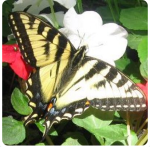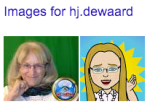“Today you are you! That is truer than true.
There is no one alive who is you-er than you.”
Dr. Seuss
Who is the ‘true you’ when you share your bio in digital spaces? How do the words, images, events, and actions reveal and evolve as you engage in digital community places?
These questions came up in a conversation with some intrepid connectors who are organizing the upcoming CLMOOC 2016. When we join together in groups in physical or digital places, the first activity is usually some form of introduction. There are variations in how people chose to share information about themselves. I’ve looked at considerations in choosing a name (What’s in a Name) and have created bio statements (About Me). There are iterations on this task with ‘unbio’ or ‘fun-bio’ forms of biographies that sometimes say less yet reveal more. Using a ‘third thing‘ can help shape atypical bio statements. Watch this video to understand how a poem, image or object can uncover and reveal the true-you?
When it comes to social media, your bio is part of your presence. Do you reveal who you are or what you do? Is there a way to reveal both?

After trying out the Twitter Bio Generator and laughing about how accurate and humorous some of the options could be, I reflected on the seven key ingredients in a great twitter bio. Maybe these could help reveal the ‘true-you’. I never thought of myself as a ‘passionate zombie buff’ but could see some accuracy in the ‘lifelong web evangelist’ statement. With Twitter bios, the character constraints can heighten your sense of urgency in crafting a bio that is focused on essentials. Unlike a tombstone marker that reveals a legacy of life, these bio statements can, and often do, change with whim or new ventures. Twitter bios can combine what you do with who you are. Creating or refreshing your Twitter bio can reveal the evolution of you in this digital space – record and celebrate this growth over time.
Images in your bio also evolve over time. Mine not only began with a generic name (hjdw) but also an avatar that didn’t reveal much of anything (see photo of butterfly) . At that time in the development of my digital biography, it was more about hiding than revealing. Iterations of avatars and images attached to my bio reveal a progression of becoming visible and comfortable with a ‘true-you’. My use and management of a gravatar image attached to my blog has also evolve over time.
. At that time in the development of my digital biography, it was more about hiding than revealing. Iterations of avatars and images attached to my bio reveal a progression of becoming visible and comfortable with a ‘true-you’. My use and management of a gravatar image attached to my blog has also evolve over time.
 Over the years, I’ve created variations and iterations of avatar images using a variety of image generators (DoppelMe, Bitstrips, PeanutizeMe, Picasso style, Van Gogh style). The evolution to using my own image as part of my bio was not a gentle shift but a conscious decision. I continue to decide where and when to share my real face or avatar image when joining connected communities. Interestingly, Bitstrips for Schools, one of my favourite ways to create an avatar and collaborative comic style conversations, has recently been bought out by Snapchat – there’s a future for cartoon versions of ‘you’.
Over the years, I’ve created variations and iterations of avatar images using a variety of image generators (DoppelMe, Bitstrips, PeanutizeMe, Picasso style, Van Gogh style). The evolution to using my own image as part of my bio was not a gentle shift but a conscious decision. I continue to decide where and when to share my real face or avatar image when joining connected communities. Interestingly, Bitstrips for Schools, one of my favourite ways to create an avatar and collaborative comic style conversations, has recently been bought out by Snapchat – there’s a future for cartoon versions of ‘you’.
What you include in your bio depends on where it will be used and who’s going to read it. Reflecting a media literacy perspective, it’s a process of considering audience, media text and production. Context is important. For the upcoming CLMOOC 2016 introductions, it’s about creativity, connecting and community. For Virtually Connecting, my (fun)bio should reveal my interests in the community and how I engage in relationships and conversations. For the Inclusive Learning Network Summer Book Study, my bio statement will connect to the purpose and theme – summertime, poolside, choice, serendipity.
Creating your own image, text, icons, and social media resources is a great way to reflect on the true ‘you-ness’. There will be evolutions as you design and reveal your bio. Don’t expect it to remain static. Be open to iterations. Find and re-mix bio’s created by others. Re-create your bio for purpose and audience. The more you do your bio, the more you learn about the true-you. Use a variety of digital tools and resources to craft and create in a style that suits YOU – try Canva, Google Draw, or Visualize.Me. You can clip or use parts of what you create in a visual resume as part of a bio statement.
How has your bio changed, evolved and been re-created? What does your bio reveal or leave hidden? Where did you craft your ‘best-ever-bio’?

Pingback: The True You: Iterations of a ‘bio’ | What Else? 1DR
This whole issue of identity and representation always fascinates me … as does the choice between allowing an algorithm to tell us who we are as opposed to making something that represents a piece of who I believe I am. Social media construction, and what we share and whom we share it with, is an incredibly rich fabric of our times. Thanks for the fantastic post, with so much to think about.
–Kevin
This issue of representation and identification is an important consideration at all ages and stages of web connection. It’s the difference between taking control of your own public display or self or letting someone else determine who or what you’ll be in digital spaces. Worthy of deeper conversations. Thanks for provoking the discourse!
Pingback: Make Cycle #1: Make with Me: Who Are We? – CLMOOC
I had been playing with an introduction to this year’s clmooc when I came here to read your post. I think your point about context is a good one. Who do we decide to be in each context? But, thinking forward, how do we perform our bio in the space for which we’ve created it? It’s not just the bio we post that defines us; it’s what other people see us as based on their (limited) acquaintance with us and the face we’ve chosen to present.
Jennifer you have added to my own difficulty with face and place in digital communities – there are certain limitations in each of the media we use to share ourselves. Images can only be interpreted certain ways. Text with an image adds another layer to increase understanding. Sound or moving images can clutter or reveal. But underlying all that is the ‘viewer’s’ own perspectives and biases. Those we can’t account for when we share our bio in whatever format we chose. Context and culture really does matter.
Pingback: What’s my number? ~ A #CLMOOC intro | Five Flames 4 Learning
I really enjoyed reading this blog post! Over the first half of the semester I’d wanted to visit your blog site, and now getting the chance to its definitely eye opening reading an experienced blogger. In regards to this blog post itself, it’s interesting to see how your digital bio’s have evolved over time. I can relate to this and say that during my time online the bio’s that I have presented in different digital spaces have evolved. In some instances I have completely deleted the bio that I previously had. When MSN was popular, I remember that having avatars were popular. I can recall choosing one to reflect the particular mood I was in that day. Now that MSN is a thing of the past and I am no longer changing my avatar everyday, I’ve now moved onto Facebook and changing profile pictures to reflect the season.
When writing my bio for my blog for this class, I was absolutely more thorough then I ever am about my personal self in any other digital space. That said, I still glossed over who I really was. Over all, I definitely keep a lot of myself hidden in my bio, especially because I rarely include one.
While visiting other users various digital spaces, do you find it easier to connect with them if they have a personalized bio verses something that could have been created by a tool such as the Twitter Bio Generator?
– Emily Anne W.
I found this post very intriguing. I really love that quote by Dr. Seuss and have always connected with it. I found it interesting that you require a different bio depending on the audience. I had noticed that Bitstrips have appeared as a feature on Snapchat and enjoy using my avatar to help express my feelings to my friends. They are neat ways to send a message. My bios are typically the same around the social media outlets that I use. Most of the time I like to use a quote or song lyrics that I feel represent or speak to me as a simple way to tell the world who I am. This is also a great way for new followers to discover what I am interested in and to possibly find something in common. The twitter-bio that the generator gave me has some aspects that describe me, but overall it was funny to play around with! It also reminds me that I haven’t updated my twitter bio in a while, so maybe I will use this!
Incurable internet practitioner. Avid tv aficionado. Web fan. Award-winning twitter fanatic. Typical pop cultureaholic. Music ninja.
How do you feel we can accurately convey our intentions in a bio with limited space?
Interesting post. It makes me want to create a more interesting image for readers using images as well as other media sources. Do you feel that more interesting biographies makes the reader feel more interested when they read the posts by that author? As well, do you believe that authors should be aware of when they use pictures of themselves in their posts?
Thank you for the fantastic post, it leaves me with a lot to think about
– Carly Rutter